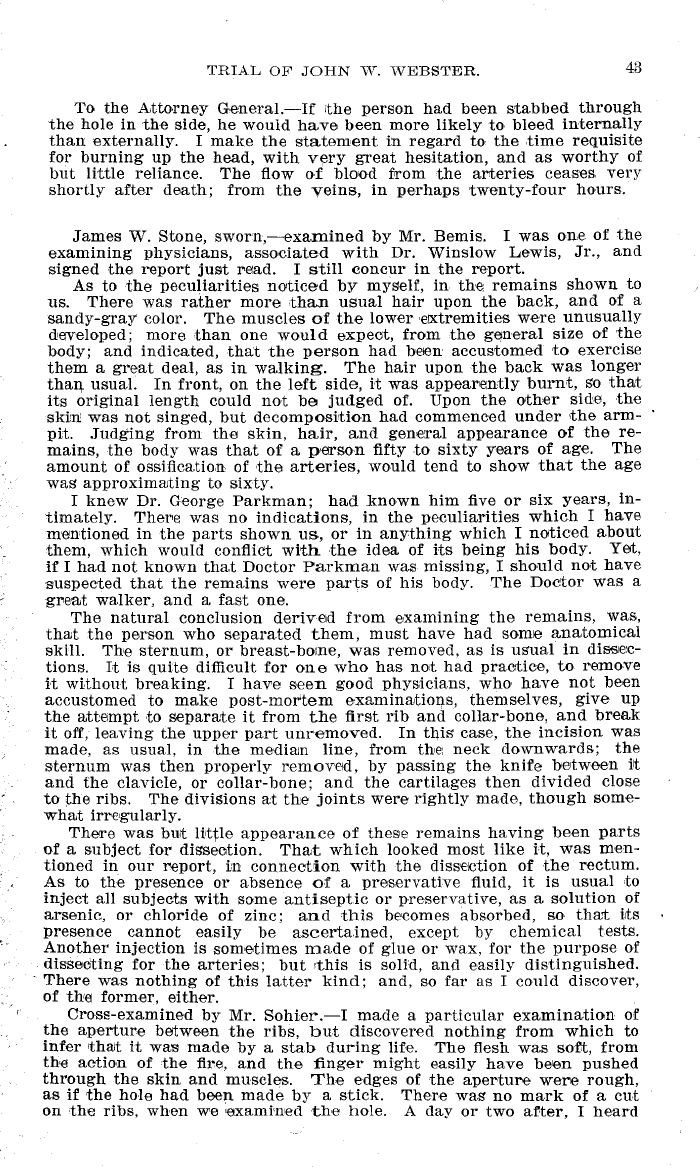|
TRIAL OF JOHN NA'. wEBSTER, 43
To the Attorney General.-If ithe person had been stabbed through
the hole in the side, he would have been more likely to bleed internally
than externally. I make the statement. in regard to the time requisite
for burning up the head, with very great hesitation, and as worthy of
but little reliance. The flow of blood from the arteries ceases very
shortly after death; from the veins, in perhaps twenty-four hours.
James W. Stone, sworn,-examined by Mr. Bemis. I was one of the
examining physicians, associated with Dr. Winslow Lewis, Jr., and
signed the report just read. I still concur in the report.
As to the peculiarities noticed by myself, in the remains shown to
us. There was rather more than usual hair upon the back, and of a
sandy-gray color. The muscles of the lower extremities were unusually
developed; more than one would expect, from the general size of 'the
body; and indicated, that the person had been accustomed to exercise
them a great deal, as in walking. The hair upon the back was longer
than usual. In front, on the left side, it was appear~ently burnt, so that
its original length could not be judged of. Upon the other side, the
skin was not singed, but decomposition had commenced under the arm-
pit. Judging from the skin, hair, and general appearance of the re-
mains, the body was that of a person fifty .to sixty years of age. The
amount of ossification of the arteries, would tend to show that the age
was approximating to sixty.
I knew Dr. George Parkman; had.known him five or six years, in-
timately. There was no indications, in the peculiarities which I have
mentioned in the parts shown us, or in anything which I noticed about
them, which would conflict with the idea of its being his body. Yet,
if I had not known that Doctor Parkman was missing, I should not have
suspected that the remains were parts of his body. The Doctor was a
great walker, and a fast one.
The natural conclusion derived from examining the remains, was,
that the person who separated them, must have had some anatomical
skill. The sternum, or breast-bone, was removed, as is usual in dissec-
tions. It is quite difficult for one who has not had practice, to remove
it without breaking. I have seen good physicians, who- have not been
accustomed to make post-mortem examinations, themselves, give up
the attempt to separate it from the first rib and collar-bone, and break
it off,- leaving the upper part unremoved. In tllis case, the incision was
made, as usual, in the median line, from the neck downwards; the
sternum was then properly removed, by passing the knife between it
and the clavicle, or collar-bone; and the cartilages then divided close
to the ribs. The divisions at the joints were rightly made, though some-
what irregularly.
. There was but little appearance of these remains having been parts
of a subject for dissection. That which looked most like it, was men-
tioned in our report, in connection with the dissection of the rectum.
As to the presence or absence of a preservative fluid, it is usual to
inject all subjects with some antiseptic or preservative, as a solution of
arsenic, or chloride of zinc; and this becomes absorbed, so that its
presence cannot easily be ascertained, except by chemical tests.
Another injection is sometimes made of glue or wax, for the purpose of
dissecting for the arteries; but this is solid, and easily distinguished.
There was nothing of this latter kind; and, so far as I could discover,
of the former, either.
Cross-examined by Mr. Sohier.-I made a particular examination of
the aperture between the ribs, but discovered nothing from which to
infer that it was made by a stab during life. The flesh was soft, from
the action of the fire, and the finger might easily have been pushed
through the skin and muscles. The edges of the aperture were rough,
as if the hole had been made by a stick. There was no mark of a cut
on the ribs, when we 4amin~ed the hole. A day or two after, I heard
|

